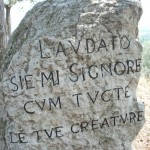I hate the periodic table. Or I thought I did. That yellowed chart flapping in front of the chemistry lecture room in the “new building” (circa 1934 or so, as opposed to the really old 1906 old building) of Immaculate Heart High School in Hollywood led directly to my having to hear, for the past 40+ years, “Whaddaya mean, you weren’t in Honors?” Indeed, I entered high school as a freshman in 1964 in Honors–and that lasted precisely the month or so it took for the periodic table to destroy me utterly. I will admit that The Beatles, the introduction of The New Math (with its bizarre non-10 bases) in Sr. Karis’s Algebra I class, the chemicals in the Nefertiti eyeliner I layered on thickly each morning after ironing my hair, and the Second Vatican Council also played contributing roles in my precipitous slide from scrupulous honor student to flunking hippie, but it was the periodic table that started the ball rolling.
I mean, look at the thing. An eye chart was easier to decode, even on those (frequent) days when I left my glasses on the bus. Letters, numbers, decimal points–did no one tell Mendeleev that Base-10 didn’t live here anymore?–and boxes related to one another by periods even more irregular than the ones I kept telling Miss Loretta Jasmin, the gym teacher, I was stricken by so I didn’t have to reveal how painfully inept I was at anything more active than diagramming a sentence. And there were, of course, far fewer of those boxes back in those days, before they started finding elements with preposterous properties (“It’s only stable for a nanosecond in deep space on the surface of an object we can’t exactly see but we really, really believe it’s there!”) and naming them for UC Berkeley. No, once the periodic table had its way with me, I vowed never to cross its path again. (I did make one exception in order to decode Goldwater bumper stickers, thereby confirming that anything associated with the periodic table was as intrinsically evil as I suspected.)
And there it would have stayed, but for Sam Kean. The periodic table sent this gifted, very funny, very young science writer to lure me–and a bunch of other people who pay attention to the NYT Books of the Year–back into its clutches. Having stumbled upon and fallen headlong into Kean’s The Disappearing Spoon And Other True Tales of Madness, Love, and the History of the World from the Periodic Table of the Elements, I wanna go back and take a chemistry class. Dang, the man is good.











